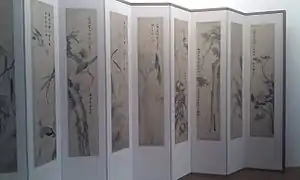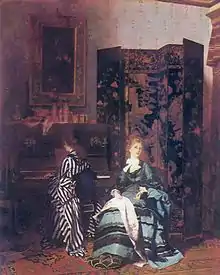Folding screen
A folding screen is a type of free-standing furniture consisting of several frames or panels, which are often connected by hinges or by other means. They have many practical and decorative uses, and can be made in a variety of designs with different kinds of materials. Folding screens originated from ancient China, eventually spreading to the rest of East Asia, Europe, and other regions of the world.

History

Origin in China
Screens date back to China during the Eastern Zhou period (771–256 BCE).[1][2] These were initially one-panel screens in contrast to folding screens.[3] Folding screens were invented during the Han dynasty (206 BCE – 220 CE).[4] Depictions of those folding screens have been found in Han-era tombs, such as one in Zhucheng, Shandong Province.[1]
A folding screen was often decorated with beautiful art; major themes included mythology, scenes of palace life, and nature. It is often associated with intrigue and romance in Chinese literature, for example, a young lady in love could take a curious peek hidden from behind a folding screen.[1][2] An example of such a thematic occurrence of the folding screen is in the classical novel Dream of the Red Chamber by Cao Xueqin.[5] The folding screen was a recurring element in Tang literature.[6] The Tang poet Li He (790–816) wrote the "Song of the Screen" (屛風曲), describing a folding screen of a newly-wed couple.[6] The folding screen surrounded the bed of the young couple, its twelve panels were adorned with butterflies alighted on China pink flowers (an allusion to lovers), and had silver hinges resembling glass coins.[6]
Folding screens were originally made from wooden panels and painted on lacquered surfaces, eventually folding screens made from paper or silk became popular too.[3] Even though folding screens were known to have been used since antiquity, it became rapidly popular during the Tang dynasty (618–907).[7] During the Tang dynasty, folding screens were considered ideal ornaments for many painters to display their paintings and calligraphy on.[2][3] Many artists painted on paper or silk and applied it onto the folding screen.[2] There were two distinct artistic folding screens mentioned in historical literature of the era. One of it was known as the huaping (Chinese: 畫屛; lit. 'painted folding screen') and the other was known as the shuping (Chinese: 書屛; lit. 'calligraphed folding screen').[3][7] It was not uncommon for people to commission folding screens from artists, such as from Tang-era painter Cao Ba or Song-era painter Guo Xi.[2] The landscape paintings on folding screens reached its height during the Song dynasty (960–1279).[1] The lacquer techniques for the Coromandel screens, which is known as kuancai (款彩 "incised colors"), emerged during the late Ming dynasty (1368-1644)[8] and was applied to folding screens to create dark screens incised, painted, and inlaid with art of mother-of-pearl, ivory, or other materials.[9]
Korea
Folding screens became significant during the period of Unified Silla (668–935).[10] Folding screens known as irworobongdo were important elements in the throne room of some Joseon kings, placed immediately behind the throne.
Japan


The byōbu (Japanese folding screen) originated from the Han Dynasty of China and is thought to have been imported to Japan in the 7th or 8th century. The oldest byōbu produced in Japan is Torige ritsujo no byōbu (鳥毛立女屏風) from the 8th century, and it is stored in Shōsōin Treasure Repository.[11] After the Heian period in the 9th century, due to the development of Japan's original Kokufū Bunka (国風文化), the designs became more indigenous and came to be used as furnishings in the architectural style of Shinden-zukuri.
The characteristic of folding screens in the Muromachi period was the spatial expression of silence, but in the Azuchi-Momoyama period, when daimyo (feudal lords) competed for supremacy, folding screens with paintings of tigers and dragons became popular.[12] In the Edo period, as the economy developed, emerging merchants became patrons in the production of folding screens. In this period, the Rinpa school folding screens were popular, which were characterized by highly decorative designs using gold or silver foil, bold compositions depicting simple objects, and repeated patterns.[13]
Spread to Europe

Folding screens were introduced in the late Middle Ages to Europe.[1] In the 17th and 18th centuries, many folding screens were being imported from China to Europe.[1][2][14] Especially the French had a certain admiration and desire for the Chinese folding screens,[2] along with the rest of Europe,[1] and they began importing large lacquered folding screens adorned with art.[1][2] The famous fashion designer Coco Chanel was an avid collector of Chinese folding screens and is believed to have owned 32 folding screens, of which eight were housed in her apartment at 31 rue Cambon, Paris.[15] She once said:
I've loved Chinese screens since I was eighteen years old. I nearly fainted with joy when, entering a Chinese shop, I saw a Coromandel for the first time. Screens were the first thing I bought.[16]
Uses
Although folding screens originated in China, they can now be found in many interior designs throughout the world.[9] Some of the first uses of folding screens were rather practical. They were used to prevent draft in homes,[9] as indicated by the two characters in their Chinese name: ping (屛 "screen; blocking") and feng (風 "breeze, wind"). They were also used to bestow a sense of privacy; in classical times, folding screens were often placed in rooms to be used as dressing screens for ladies.[9] Folding screens can be set up to partition a large room and change the interior features of the space.[9] Screens may be used as a false wall near the entrance from one room to another to create a desirable atmosphere by hiding certain features like doors to a kitchen.[9][17] As many folding screens have fine artistic designs and art on them, they can fit well as decorative items in the interior design of a home.[9][17]
See also
| Wikimedia Commons has media related to Folding screens. |
- Room divider
- Chinoiserie
- Coromandel screen
- Hanging scroll
- Rood screen and triptych: panels in churches
- Shower
References
- Handler, Sarah (2007). Austere luminosity of Chinese classical furniture. University of California Press. pp. 268–271, 275, 277. ISBN 978-0-520-21484-2.
- Mazurkewich, Karen; Ong, A. Chester (2006). Chinese Furniture: A Guide to Collecting Antiques. Tuttle Publishing. pp. 144–146. ISBN 978-0-8048-3573-2.
- Needham, Joseph; Tsien, Tsuen-hsuin (1985). Paper and printing, Volume 5. Cambridge University Press. p. 120. ISBN 978-0-521-08690-5.
- Lee, O-Young; Yi, Ŏ-ryŏng; Holstein, John (1999). Things Korean. Tuttle Publishing. p. 135. ISBN 978-0-8048-2129-2.
- Tian, Jiaqing (1996). Classic Chinese furniture of the Qing dynasty. Philip Wilson. p. 54.
- Handler, Sarah (2001). Austere luminosity of Chinese classical furniture. Berkeley: University of California Press. p. 275. ISBN 9780520214842.
- van Gulik, Robert Hans (1981). Chinese pictorial art as viewed by the connoisseur: notes on the means and methods of traditional Chinese connoisseurship of pictorial art, based upon a study of the art of mounting scrolls in China and Japan. Hacker Art Books. p. 159. ISBN 978-0-87817-264-1.
- Clunas, Craig (1997). Pictures and visuality in early modern China. London: Reaktion Books. p. 61. ISBN 978-1-86189-008-5.
- Cooper, Dan (1999). "Folding Grandeur". Old House Interiors. 5 (1): 30–36. ISSN 1079-3941.
- Kim, Kumja Paik (2006). The art of Korea: Highlights from the collection of San Francisco's Asian Art Museum. San Francisco: Asian Art Museum. p. 32. ISBN 978-0-939117-31-4.
- 鳥毛立女屏風 第1扇 Imperial Househpld Agency
- Azuchi-Momoyama Period 1573-1603 JapanVisitor.com
- 琳派とは?知っておきたい琳派の巨匠と代表作 January 15, 2019
- "What is a coromandel screen?". Quezi. Uclue. Archived from the original on 27 July 2011. Retrieved 9 August 2011.
- "Coco Chanel's apartment: the Coromandel screens". Chanel News. June 29, 2010.
- Delay, Claude (1983). Chanel Solitaire. Gallimard. p. 12. Cited in: "COCO CHANEL'S APARTMENT THE COROMANDEL SCREENS". Chanel News. June 29, 2010.
- Koll, Randall; Ellis, Casey (2004). The organized home : design solutions for clutter-free living. Gloucester, Mass.: Rockport. p. 41. ISBN 978-1-59253-018-2.